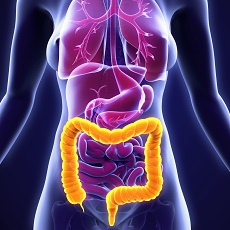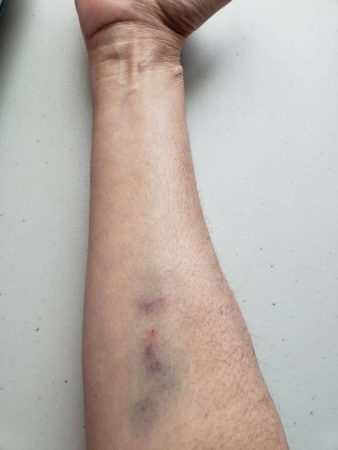When I turned 50, one of the milestone diagnostics for half-century-year-olds is a colonoscopy. OH JOY! The alternative — a potentially missed cancerous growth.
Colonoscopy — a necessity of a healthy life… or not?
My father was living with late-middle-stage of Alzheimer’s symptoms when a stool sample showed fecal occult blood. The doctor recommended that my father get a colonoscopy to investigate the cause.
I was in my late thirties at the time and a good decade away from my first colonoscopy. Not knowing much, I asked questions. Beyond my father’s doctors, I asked caregiver support group members.
A quarter century later, I’ve learned that gastroenterologists (and many surgeons) want to do procedures. It’s their livelihood. Back then, I also learned from fellow family caregivers that people with dementia often decline further following anesthesia.
The blood in my father’s fecal sample was a dark color. If it had been bright red, it could portend something more significant. My father’s priority was to live his best quality of life without enduring the preparation-trauma and risk of further decline following a colonoscopy.
 More than a decade later after I had my first colonoscopy, I am glad I made the decision for him to pass on the procedure.
More than a decade later after I had my first colonoscopy, I am glad I made the decision for him to pass on the procedure.
My Second Colonoscopy
Twelve-and-a-half years later, I went in for my recommended 10-year follow-up.
Colonoscopy Result: 6mm polyp removed from the traverse colon. The lab results should be available later this month. Here’s a video (not mine!) of the procedure.
I believe in the power of thoughts and prayers and welcome your positive energy. When I had a breast-tissue biopsy years earlier the positive energy was welcome as were the results that found nothing.
Colonoscopy Prep
Preparing is the worst part. This time, it didn’t seem as bad. A dozen years ago, after drinking a gallon of that thickened fluid, I had not eliminated. My stomach was so distended, I grew concerned. I called the doctor’s office three times. The third time, the nurse let me talk to the doctor. It turned out; my body was slow to react.
The one positive from both experiences, is that I rarely felt hunger. This time, I drank fluids and coconut water to replenish the potassium and electrolytes I was losing due to the high doses of magnesium citrate.
Two 10-ounce bottles. How bad can they be? The lemon flavor was tolerable. Four hours later, the cherry flavor burned like 150-proof Everclear. These two bottles at almost 20-times the recommended daily dose loosened what remained in my intestines. Three hours later, I took 6 Dulcolax tabs (3 times the recommended dose). Mission nearly accomplished. I woke early enough to drink coffee (need caffeine) and more coconut water to hydrate and overcome hangover-like symptoms due to mineral loss.
Bathroom Trips & Tip
I used the bathroom more often this time. In fact, I kept a gallon of bleach close at hand to clean the toilet frequently. Yes, it’s gross, but the Dulcolax caused nausea. If I needed to vomit, I certainly wanted to face a clean toilet.
Be sure to have moist flushable wipes. If none, slightly moisten toilet tissue with water. Both, worked magnificently to prevent irritation, soreness, and pain, while keeping the area clean. If you have a bidet, even better!
Where’s my doctor?
After all this, I was ready. They prepped me for the procedure. Hey, where’s my doctor? The one who performed my colonoscopy a dozen years ago. He’s in India? While the doctor who performed the procedure did a fine job as best as I can tell, I was not pleased that the office did not notify me days earlier. I know this is only a procedure, albeit an invasive one. Imagine switching surgeons!
Local Anesthesia
A dozen years ago, I had total anesthesia for my first experience. When I awoke, I was pleased to see the smiling face of a cute doctor… the same one who was now in India. This time, I chose local anesthesia. I was intrigued to learn that my insurance did not cover total anesthesia. I wanted to view the monitor while the doctor performed the procedure. I did however consent to anesthesia in case the pain was too great. It wasn’t.
Surprisingly, the procedure went smoothly. I did feel slight pressure at times. The Valium-like calming agent was delivered via IV. It was supposed to only take the edge off. I was calm and awake. I commented during the entire procedure.
NOT!
Really? A Polyp?
It turns out the dose may have been a bit too much. I have no recollection of the doctor removing a 6mm polyp. He says he mentioned it before, during, and after. His and his team’s word against mine.
During the days afterward, my typically positive thoughts focused on whether this added procedure was just for profit. When I consider how many patients the doctors see each week, one polypectomy per over-sixty patient can increase profits by an impressive multiple!
What else did I miss? I thought I watched the entire thing. I am in disbelief!
While I believed I was awake during the entire procedure, I am unnerved that I cannot recall the polyp removal. What else did I miss?
How is it that I recall carefully removing my nasal cannula from under my mask but do not recall being transported from the procedure room to the recovery area?

No Pain, Except…
During the days that followed, since the May 2nd procedure, I felt no pain. No need to walk like a cowgirl, either.
The only lasting memory is the big bruise on my right forearm where they hooked up the IV.
I’ll learn more details in June during my follow-up appointment.
Unless there’s a different outcome with the polyp biopsy, I’ll need to return for a colonoscopy in five years instead of 10. Ooooh, lucky me!
For more information, visit the CDC’s Colorectal Cancer Screening page
Communications between caregivers and doctors Caregivers serve as a bridge between doctors








